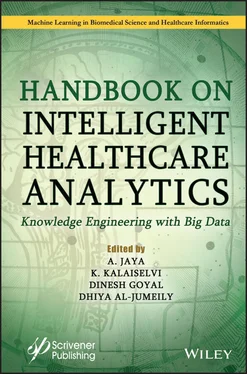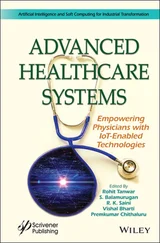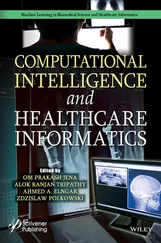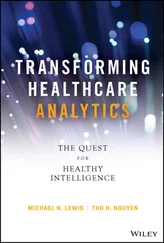Handbook on Intelligent Healthcare Analytics
Здесь есть возможность читать онлайн «Handbook on Intelligent Healthcare Analytics» — ознакомительный отрывок электронной книги совершенно бесплатно, а после прочтения отрывка купить полную версию. В некоторых случаях можно слушать аудио, скачать через торрент в формате fb2 и присутствует краткое содержание. Жанр: unrecognised, на английском языке. Описание произведения, (предисловие) а так же отзывы посетителей доступны на портале библиотеки ЛибКат.
- Название:Handbook on Intelligent Healthcare Analytics
- Автор:
- Жанр:
- Год:неизвестен
- ISBN:нет данных
- Рейтинг книги:4 / 5. Голосов: 1
-
Избранное:Добавить в избранное
- Отзывы:
-
Ваша оценка:
- 80
- 1
- 2
- 3
- 4
- 5
Handbook on Intelligent Healthcare Analytics: краткое содержание, описание и аннотация
Предлагаем к чтению аннотацию, описание, краткое содержание или предисловие (зависит от того, что написал сам автор книги «Handbook on Intelligent Healthcare Analytics»). Если вы не нашли необходимую информацию о книге — напишите в комментариях, мы постараемся отыскать её.
The book explores the various recent tools and techniques used for deriving knowledge from healthcare data analytics for researchers and practitioners. A Handbook on Intelligent Healthcare Analytics
Handbook on Intelligent Healthcare Analytics — читать онлайн ознакомительный отрывок
Ниже представлен текст книги, разбитый по страницам. Система сохранения места последней прочитанной страницы, позволяет с удобством читать онлайн бесплатно книгу «Handbook on Intelligent Healthcare Analytics», без необходимости каждый раз заново искать на чём Вы остановились. Поставьте закладку, и сможете в любой момент перейти на страницу, на которой закончили чтение.
Интервал:
Закладка:
3.4.3 Big Data Knowledge Management Systems in Healthcare
The knowledge management system is used to generate, store, distribute, use, and reuse the valuable information, knowledge, and insights by means of information technologies.
The knowledge system in healthcare is to create, store, share, and reuse valuable information. Adoption of knowledge management systems in the healthcare industry is very challenging. Gathering of information from various sources and processing of that information needs the latest tools and technologies. Big data knowledge system refers to finding the knowledge from raw data. Big data analytics is the way to transform the raw big healthcare data into knowledge. Data, business intelligence, and machine learning are the most important in big data knowledge systems. The big raw healthcare data is transformed to insights using business intelligence, and then, insights are transformed to knowledge with machine learning and artificial intelligence. Figure 3.4depicts the information flow and knowledge discovery process of healthcare big data.
Healthcare is based on knowledge such as medical knowledge, clinical knowledge, health service knowledge, and disease knowledge. So, healthcare services are knowledge-based services. All this knowledge enables the doctors to make better decisions in the treatment process with care. This knowledge is continuously evolving, based on new diseases and new drugs. The healthcare professional must learn constantly to provide up to date patient care.
The healthcare industry uses the “healthcare knowledge management systems”, for better services to the patients with improved efficacy.
Advantages of knowledge management system in healthcare are as follows [16]:
• Improved patient services
• Medical error reduction
• Reduction of healthcare cost
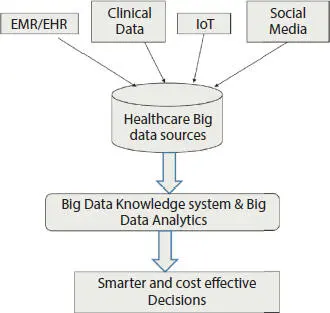
Figure 3.4 Knowledge discovery process of big data in healthcare.
The big data knowledge system transforms the raw data set into data insights, which lead to a better treatment at a lower cost.
Knowledge discovery is the method for transforming raw big data into useful information. The important elements of knowledge discovery are data, analytical tools, methods, and understanding of the domain [17]. Big data analytics is used to discover meaningful insights from the big data set. Machine learning, cloud computing, data science, natural language processing, text analytics, predictive analytics, statistical investigation, data mining, and artificial intelligence are advanced big data analytical techniques. This technique gains new knowledge from the data. All of the data is not readily usable in big data analytics. They have to undergo a “data cleansing process” to make it understandable. Understanding the details about, where the raw data come from and how they have to be treated before analyzing them, are also important. So, the data have to go through a process called “Extract, Transform, and Load” (ETL) before it can be analyzed. The data are harvested, that is, “Extracted”. Then, the data is formatted to make it readable, by an application that is “Transformed”. Then, the data is stored in the memory for reuse, that is, “Loaded”. This is called the ETL process.
3.4.4 Big Data Analytics in Healthcare
Big data analytics is the process of discovering knowledge. The stages of healthcare big data analysis are descriptive, diagnostic, predictive, and prescriptive [7, 27]. These analytical stages give the answer for the following questions:
• What happened to the patient?—Descriptive Analytics
• Why did it happen and when?—Diagnostic Analytics
• What will happen in the future?—Predictive Analytics
• How can we make it happen or not?—Prescriptive Analytics
The following are the categories of the healthcare big data analytics [18–20].
Descriptive analytics : This analytics summarizes past data in an easily readable format. This is like reporting. This gives the information, like what happened and when. The descriptive analytics in healthcare data gives the answer for the following questions:
• How many patients were in the emergency ward in the last month?
• How many numbers of patients have been infected because of epidemic disease in the last three months?
The descriptive analytics give the details for the above question using data. The descriptive analytics gives answers in simple statistical measures such as count and percentages.
For example, how many people have been infected with COVID-19 in the last month? From descriptive analytics, the hospital management can discover the number of people infected with COVID-19 in the last month. For example, we can discover from the descriptive analytics that 10,000 people are infected with COVID-19 in the last month. Descriptive analytics looks at the last month’s data and gives the answer in number. The government and the healthcare organization are able to identify the problem with current clinical aspects and get better healthcare practice, using the report of descriptive analysis. This is the first step of analyzing the big data that transforms the raw data into precious knowledge. Descriptive analytics is mainly for reporting, monitoring, and visualization.
Diagnostic analytics : This type of analytics gives information like what happened and why. The diagnostic analytics give explanation for the descriptive analytics data. The diagnostic analytics give answers for the following questions:
• Why were the patients infected with a particular disease last month?
• Why were the patients in the emergency ward last month?
The diagnostic analytics goes a little beyond reporting, that is, descriptive analytics. The above question can be answered using the data with the business intelligence for insight. For example, diagnostic analytics analyze the big healthcare data to discover the reason for why these patients are infected with COVID-19.
Predictive analytics : Predictive analytics uses machine learning and artificial Intelligence to analyze the present and the past data. This type of analytics is used to predict and forecast the future. The predictive analytics use descriptive data to forecast what will happen in the future possibly. This predictive analysis is the very significant analytics for predicting and diagnosing the disease. These types of analysis have capability for controlling and avoiding non communicable diseases like cancer, heart disease, stroke, and diabetes. Noncommunicable diseases are together accountable for most of the deaths worldwide. The predictive analytics use patient history and patient current health information to make medical decisions. The predictive analytics identify the following:
• Identify the patients who have the maximum possibility of getting diabetics, stroke, and heart attack?
• Identify the patients who have the maximum risk of hospitalization?
The above questions are answered using the data and machine learning for forecasting. In predictive analytics, the researchers and data analysts train a model using data mining algorithms, machine learning techniques, artificial intelligence, and the deep learning algorithms to predict the future events.
Prescriptive analytics : This analytics makes recommendations from the predicted output. The prescriptive analytics in healthcare is the last course of action in analyzing medical big data. This analysis has the capacity to suggest the action to overcome the problem in the healthcare organization. The imminent opportunity and challenges of medical big data is prescriptive analytics. Prescriptive analytics is the most advanced level of data analytics in medical big data. It is going to be realistic in the near future due to machine learning techniques, data science, cloud computing, deep learning, data engineering, and artificial intelligence.
Читать дальшеИнтервал:
Закладка:
Похожие книги на «Handbook on Intelligent Healthcare Analytics»
Представляем Вашему вниманию похожие книги на «Handbook on Intelligent Healthcare Analytics» списком для выбора. Мы отобрали схожую по названию и смыслу литературу в надежде предоставить читателям больше вариантов отыскать новые, интересные, ещё непрочитанные произведения.
Обсуждение, отзывы о книге «Handbook on Intelligent Healthcare Analytics» и просто собственные мнения читателей. Оставьте ваши комментарии, напишите, что Вы думаете о произведении, его смысле или главных героях. Укажите что конкретно понравилось, а что нет, и почему Вы так считаете.
